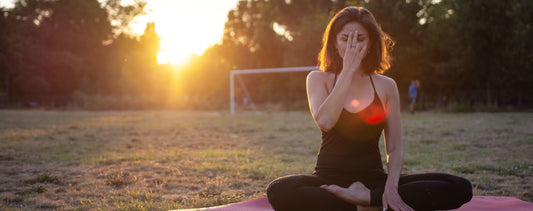Savasana might look like a nap at the end of your yoga practice. But it’s actually a fully conscious pose aimed at being awake, yet completely relaxed. In Savasana—also known as corpse pose— you lie down on your back and relax your body and mind so you may fully assimilate the benefits of your asana practice.
During this pose, you close your eyes, breathe naturally, and practice eliminating tension from the body. Ideally, this posture lasts for 10 to 20 minutes. However, even a few minutes of Savasana can have powerful benefits.
savasana-thought-bubbles-0.jpeg
This simple-sounding pose is more difficult than you might realize. The body can cause distractions that make it a challenge. Your body might feel cold, itchy, or unsettled. Savasana occurs at the end of the yoga practice to remedy this obstacle. By the time you’ve completed asanas, or postures, your body and mind should be tired enough to be able to relax sufficiently for Savasana. Think of it like taking your dog to the park or your kid to Disneyland—the drive home is often the quietest and calmest of the day.
Even if your body is amenable to the rest, your mind can get in the way. Some common thoughts that pop up during Savasana:
It’s normal for the mind to try to resist deep relaxation. Savasana is the ultimate act of conscious surrender. It takes practice and patience to surrender easily.
With the world moving so quickly, cultivating the art of Savasana is more valuable than ever. Our society tends to place greater value on speed and productivity; learning how to do nothing is a skill that can help you become more productive when you need to be.
Savasana helps us learn how to completely surrender, stop fighting the clock, and make space for peace and harmony to fill the soul. Savasana is like turning off your computer when it’s acting up. Once you reboot it, the computer often has greater functionality.
2. Take one final cleansing breath. Your teacher will likely prompt you to take one audible exhale, signaling to your body to release into the pose. This cleansing breath also sends a message to your parasympathetic nervous system that it is safe to relax and be just as you are.
3. Scan for tension. Mentally run through all the parts of your body and try to make them heavier. Be on the lookout for tension hiding in the jaw, temples, shoulders, and hips because stress likes to accumulate in these areas.
4. Then, just notice. Some days will be easier than others, and that’s part of the practice. See if you can be still, at ease, and simply trust that the breath will carry you to the next moment. Watch for those peaceful moments of quiet between the thoughts. Over time, they’ll get longer, and you’ll find more inner quiet.
5. Set an intention. Before you come out of Savasana, take a mental snapshot of how you feel on every level. Ask yourself what you’d like to take with you from your practice, and what you might like to leave behind. Seal these observations into your psyche with an inner smile, and then enjoy a deep inhale to awaken and emerge into your day. Now take a moment to notice that you feel more rested, awake, and alive than you did before.
Savasana is a time of rest, but not a time to sleep. If you have a tendency to fall asleep, the first step is to be compassionate with yourself, and acknowledge that your body needed some rest. Over time, you can train yourself to achieve the rest you need while remaining awake.
Give your Savasana the same attention you give to your Adho Mukha Svanasana (Downward Dog) and your Virabhadrasana (Warrior II) poses, and notice the effects. If you consistently practice calm and surrender on the mat, it will become easier when you’re no longer on it, which is ultimately why we all practice yoga in the first place.
*Editor’s Note: The information in this article is intended for your educational use only and is not a substitute for professional medical advice, diagnosis, or treatment. Always seek the advice of your physician or other qualified health providers with any questions you may have regarding a medical condition and before undertaking any diet, supplement, fitness, or other health programs.
During this pose, you close your eyes, breathe naturally, and practice eliminating tension from the body. Ideally, this posture lasts for 10 to 20 minutes. However, even a few minutes of Savasana can have powerful benefits.
The Benefits of Savasana
Savasana helps relieve mild depression, high blood pressure, headaches, fatigue, and insomnia, according to Yoga Journal. Savasana can calm the nervous system and promote equanimity in your entire body. Fatigued muscles get to relax, tense shoulders and jaws soften, and the eyes quiet down to reflect a quieter state of mind.Common Challenges of Savasana
This simple-sounding pose is more difficult than you might realize. The body can cause distractions that make it a challenge. Your body might feel cold, itchy, or unsettled. Savasana occurs at the end of the yoga practice to remedy this obstacle. By the time you’ve completed asanas, or postures, your body and mind should be tired enough to be able to relax sufficiently for Savasana. Think of it like taking your dog to the park or your kid to Disneyland—the drive home is often the quietest and calmest of the day.
Even if your body is amenable to the rest, your mind can get in the way. Some common thoughts that pop up during Savasana:
- How much longer will we be here?
- Did that guy just snore? That’s embarrassing.
- I hope I didn’t just snore.
- What am I making for dinner when I get home?
- Is this relationship really working out?
- I’m hungry.
- What’s my life all about, anyway?
- I smell like sweat.
- Did I remember to pay the meter?
- Maybe I should quit my job.
It’s normal for the mind to try to resist deep relaxation. Savasana is the ultimate act of conscious surrender. It takes practice and patience to surrender easily.
With the world moving so quickly, cultivating the art of Savasana is more valuable than ever. Our society tends to place greater value on speed and productivity; learning how to do nothing is a skill that can help you become more productive when you need to be.
Savasana helps us learn how to completely surrender, stop fighting the clock, and make space for peace and harmony to fill the soul. Savasana is like turning off your computer when it’s acting up. Once you reboot it, the computer often has greater functionality.
5 Steps to a Successful Savasana
1. Set yourself up for success. Stretch out on your mat and be sure you’re completely comfortable. Use bolsters, pillows, blankets, and cover your eyes with an eye pillow or towel. The more comfortable you are, the more you can relax. The more relaxed you are, the more easily you can surrender. The more open you are to surrendering, the more benefits you’ll receive.2. Take one final cleansing breath. Your teacher will likely prompt you to take one audible exhale, signaling to your body to release into the pose. This cleansing breath also sends a message to your parasympathetic nervous system that it is safe to relax and be just as you are.
3. Scan for tension. Mentally run through all the parts of your body and try to make them heavier. Be on the lookout for tension hiding in the jaw, temples, shoulders, and hips because stress likes to accumulate in these areas.
4. Then, just notice. Some days will be easier than others, and that’s part of the practice. See if you can be still, at ease, and simply trust that the breath will carry you to the next moment. Watch for those peaceful moments of quiet between the thoughts. Over time, they’ll get longer, and you’ll find more inner quiet.
5. Set an intention. Before you come out of Savasana, take a mental snapshot of how you feel on every level. Ask yourself what you’d like to take with you from your practice, and what you might like to leave behind. Seal these observations into your psyche with an inner smile, and then enjoy a deep inhale to awaken and emerge into your day. Now take a moment to notice that you feel more rested, awake, and alive than you did before.
Savasana is a time of rest, but not a time to sleep. If you have a tendency to fall asleep, the first step is to be compassionate with yourself, and acknowledge that your body needed some rest. Over time, you can train yourself to achieve the rest you need while remaining awake.
Give your Savasana the same attention you give to your Adho Mukha Svanasana (Downward Dog) and your Virabhadrasana (Warrior II) poses, and notice the effects. If you consistently practice calm and surrender on the mat, it will become easier when you’re no longer on it, which is ultimately why we all practice yoga in the first place.
*Editor’s Note: The information in this article is intended for your educational use only and is not a substitute for professional medical advice, diagnosis, or treatment. Always seek the advice of your physician or other qualified health providers with any questions you may have regarding a medical condition and before undertaking any diet, supplement, fitness, or other health programs.






















